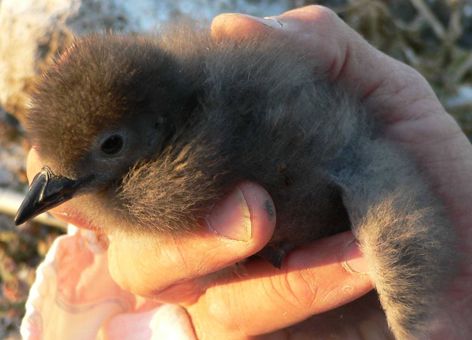Despite Threats, Celebrating Restoration Successes for Seabirds in California
JANUARY 22, 2015 -- Seabirds: You may see them perched along a fishing pier poised to scavenge or swooping for fish by the thousands out in the open ocean. This diverse group of marine birds serves as a valuable indicator of the health of the ocean and what they have been telling us lately is that they face many threats. Often victims of oil spills and other pollution, seabirds are threatened by a changing climate, hunting, and introduced species (such as rats or feral cats). In addition, they frequently get caught in fishing nets, a serious concern for many seabirds, particularly if they dive for food. Yet it's not all bad news for our feathered friends. Help is on the way.
Bait and Switch
While nearly 7,000 birds were estimated killed after the container ship Cosco Busan spilled heavy oil into San Francisco Bay in 2007, restoration projects are already underway. In 2014 alone, over $15 million was spread across more than 50 projects to enhance and restore beaches and habitat, including seabird habitat, around the Bay Area. One project in particular is aimed at undoing the damage done to the threatened Marbled Murrelet. In order for these small, chubby seabirds to recover from this oil spill, they need some help keeping jays from eating their eggs. For three years in a row, a restoration project has been working on this in the old growth forests around campgrounds in the Santa Cruz Mountains. From the Cosco Busan Oil Spill Trustee Council [PDF]: "In order to train jays not to eat murrelet eggs, hundreds of chicken eggs were painted to look like murrelet eggs, injected with a chemical that makes the jays throw up, and placed throughout the forest. Monitoring suggests the jays learn to avoid the eggs and may teach their offspring as well."
Cleaning up the Neighborhood
Meanwhile, down the California coast, seabirds in the Channel Islands were suffering as a result of the pesticide DDT and industrial chemicals that were dumped into the ocean by local industries years ago. The birds themselves were contaminated by the pollution and their eggshells became dangerously thin, reducing reproduction—a notorious effect of DDT. On top of all that, human activities had been altering seabird habitat on these islands for years. NOAA's Montrose Settlements Restoration Program has been focused on reversing this harmful trend with a number of projects to restore seabird nesting habitat, attract seabirds to the restored sites, and to remove non-native plants and animals on the Channel Islands and Baja California Pacific Islands. On Scorpion Rock, a small islet located off the northeast coast of Santa Cruz Island, biologists have been transforming the inhospitable landscape for Cassin’s Auklets, a small open-ocean seabird. Scorpion Rock had been overrun with dense, non-native ice plant which prevented the seabirds from digging burrows to nest and provided little protection from predators. Begun in 2008, the restoration of Scorpion Rock is nearly complete. The island now boasts a lush cover of 17 different native plant species, including shrubs that stabilize the soil and offer cover for nesting birds. That work has been paying off. According to the Montrose Settlements Restoration Program: "Biologists have seen a 3-fold increase in the number of natural Cassin's Auklets burrows since the project started. Over the last few years, biologists have also observed a lower number of dead adult auklets which means that the native plants are providing adequate cover from predators." In the final year of the project, the plan is to use sounds of breeding seabirds to attract greater numbers to the restored habitat on Scorpion Rock, and continue maintaining the native vegetation and monitoring the birds' recovery. Learn more about this and other seabird restoration projects in the Channel Islands and watch a video from 2010 about the restoration at Scorpion Rock during its earlier stages:
 An official website of the United States government.
An official website of the United States government. 

